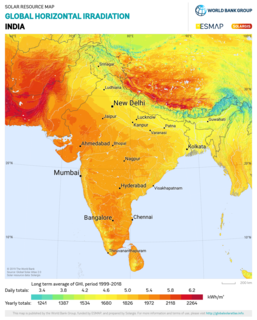A condominium, often shortened to condo in the United States and in most Canadian provinces, is a type of living space similar to an apartment but independently sellable and therefore regarded as real estate. The condominium building structure is divided into several units that are each separately owned, surrounded by common areas that are jointly owned. Condominiums are a type of common-interest development (CID). Similar concepts in other English-speaking countries include strata title in Australia, Malaysia, New Zealand, and the Canadian province of British Columbia; commonhold in the England and Wales; and sectional title in South Africa.

A solar inverter or PV inverter, is a type of electrical converter which converts the variable direct current (DC) output of a photovoltaic (PV) solar panel into a utility frequency alternating current (AC) that can be fed into a commercial electrical grid or used by a local, off-grid electrical network. It is a critical balance of system (BOS)–component in a photovoltaic system, allowing the use of ordinary AC-powered equipment. Solar power inverters have special functions adapted for use with photovoltaic arrays, including maximum power point tracking and anti-islanding protection.
A league is a unit of length. It was common in Europe and Latin America, but is no longer an official unit in any nation. Derived from an ancient Celtic unit and adopted by the Romans as the leuga, the league became a common unit of measurement throughout western Europe. It was intended to represent, roughly, the distance a person could walk in an hour. Since the Middle Ages, many values have been specified in several countries.

A community garden is a single piece of land gardened collectively by a group of people. Community gardens utilize either individual or shared plots on private or public land while producing fruit, vegetables, and/or plants grown for their attractive appearance. Around the world, community gardens can fulfill a variety of purposes such as aesthetic and community improvement, physical or mental well-being, or land conservation.

Human rights in Spain are set out in the 1978 Spanish constitution. Sections 6 and 7 guarantees the right to create and operate political parties and trade unions so long as they respect the Constitution and the law.

Solar power in India is a fast developing industry. The country's solar installed capacity was 36.9 GW as of 30 November 2020.
The Spanish and Mexican governments made many concessions and land grants in Alta California from 1785 to 1846. The Spanish Concessions of land were made to retired soldiers as an inducement for them to remain in the frontier. These Concessions reverted to the Spanish crown upon the death of the recipient. The Mexican government later encouraged settlement by issuing much larger land grants to both native-born and naturalized Mexican citizens. The grants were usually two or more square leagues, or 35 square kilometres (14 sq mi) in size. Unlike Spanish Concessions, Mexican land grants provided permanent, unencumbered ownership rights. Most ranchos granted by Mexico were located along the California coast around San Francisco Bay, inland along the Sacramento River, and within the San Joaquin Valley.

The climate of the Arctic is characterized by long, cold winters and short, cool summers. There is a large amount of variability in climate across the Arctic, but all regions experience extremes of solar radiation in both summer and winter. Some parts of the Arctic are covered by ice year-round, and nearly all parts of the Arctic experience long periods with some form of ice on the surface.

The Space Flyer Unit was a spacecraft which was launched by Japan on Mar. 18, 1995.
The nominal power is the nameplate capacity of photovoltaic (PV) devices, such as solar cells, modules and systems, and is determined by measuring the electric current and voltage in a circuit, while varying the resistance under precisely defined conditions. The nominal power is important for designing an installation in order to correctly dimension its cabling and converters.

The Solar Platform of Almería (PSA) is the largest concentrating solar technology research, development and test centre in Europe, situated in the Province of Almería, Spain in Tabernas.
Prior to World War II, agriculture in Bulgaria was the leading sector in the Bulgarian economy. In 1939, agriculture contributed 65 percent of Net material product (NMP), and four out of every five Bulgarians were employed in agriculture. The importance and organization of Bulgarian agriculture changed drastically after the war, however. By 1958, the Bulgarian Communist Party (BCP) had collectivized a high percentage of Bulgarian farms; in the next three decades, the state used various forms of organization to improve productivity, but none succeeded. Meanwhile, private plots remained productive and often alleviated agricultural shortages during the Todor Zhivkov era.

The Ivanpah Solar Electric Generating System is a concentrated solar thermal plant in the Mojave Desert. It is located at the base of Clark Mountain in California, across the state line from Primm, Nevada. The plant has a gross capacity of 392 megawatts (MW). It deploys 173,500 heliostats, each with two mirrors focusing solar energy on boilers located on three 459 ft tall solar power towers. The first unit of the system was connected to the electrical grid in September 2013 for an initial synchronisation test. The facility formally opened on February 13, 2014. In 2014, it was the world's largest solar thermal power station.

The Solnova Solar Power Station is a large CSP power station made up of five separate units of 50 MW each. The facility is part of the Solucar Complex, in Sanlúcar la Mayor, in Spain, the same area where the PS20 solar power tower is also located. With the commissioning of the third 50 MW unit, the Solnova-IV in August 2010, the power station ranks as one of the largest CSP power stations in the world.

A photovoltaic power station, also known as a solar park, solar farm, or solar power plant is a large-scale photovoltaic system designed for the supply of merchant power into the electricity grid. They are differentiated from most building-mounted and other decentralised solar power applications because they supply power at the utility level, rather than to a local user or users. The generic expression utility-scale solar is sometimes used to describe this type of project.

Tisquesusa, also spelled Thisquesuza, Thysquesuca or Thisquesusha was the fourth and last independent ruler (zipa) of Bacatá, main settlement of the southern Muisca between 1514 and his death in 1537. The name brought about the Colombian capital Bogotá. Tisquesusa was the ruler of the southern Muisca Confederation at the time of the Spanish conquest of the Muisca, when the troops led by Gonzalo Jiménez de Quesada and his brother entered the central Colombian highlands. His zaque counterpart in the northern area of the Muisca was Quemuenchatocha.
Visakhapatnam Special Economic Zone (VSEZ), also called the Andhra Pradesh First Economic Zone, is one of the central government special economic zones in India. VSEZ is located in Duvvada, 20 km away from the Visakhapatnam.

Sol is a solar day on Mars; that is, a Mars-day. A sol is the apparent interval between two successive returns of the Sun to the same meridian as seen by an observer on Mars. It is one of several units for timekeeping on Mars.
The caballería was a unit of land measurement in the Spanish viceroyalties in the Americas during the times of the Spanish Empire in the 16th through 19th centuries Spanish West Indies. The unit was widely use in Puerto Rico, where it was equivalent to 78.58 hectares. The unit, however, came from Spain, where it had already been in use.

The San Francisco Bay Salt Ponds are an approximately 16,500-acre (6,700 ha) part of the San Francisco Bay that have been used as salt evaporation ponds since the California Gold Rush era. Most of the ponds were once wetlands in the cities of Redwood City, Newark, Hayward and other parts of the bay.












